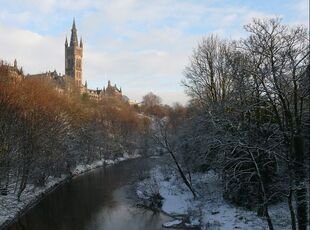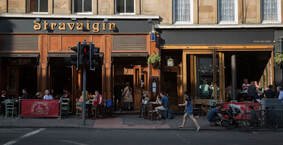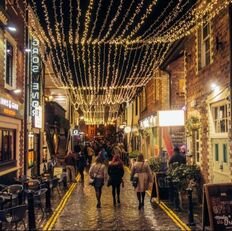OHBM2022 in Glasgow
By Nils Muhlert and Niall Duncan
This year, OHBM’s annual meeting will be held in Glasgow, in Bonnie Scotland! This 28th annual meeting, from the 19th to 23rd of June, features a packed scientific programme where you’ll discover the latest in neuroimaging developments from around the world. At the same time, there’ll be a whole host of events to facilitate networking, to show you the delights of the Scottish Lowlands, and to quench that thirst for physical conferences that many of us have developed over the past years*.
The conference is geared for researchers at all career stages. The core of the meeting remains the keynote speakers and symposia. This year you can hear from our Talairach awardee, Prof Andres Lozano, about his truly phenomenal work combining imaging with deep brain stimulation. Find out about the brain basis of social decision making from Dr Yina Ma, machine learning models and pattern recognition in neuroimaging from Prof Janaina Mourao-Miranda, and about how oscillatory brain activity enables cognition from Prof Ole Jensen, amongst others. Take part in Sunday’s educational events, where you can learn from world-leading experts about quantitative MRI, neuroanatomy, physiologic fMRI, time varying functional connectivity, or develop a core understanding in a number of fields.
Join in with the open science activities. The annual OHBM hackathon takes place in Glasgow from the 16th to 18th June. The open science room, now a central feature of the annual meeting, has activities planned throughout - symposia, table topics (with group discussions and Q&As) and emergent sessions. Find out how researchers from developing countries have tackled open science practices and what they’ve learned, debunk myths about open code and learn about various career paths in academia and industry after the PhD. Dive into the many activities covering the sea of open science - how can you miss out on that?
Once you’re saturated with ideas for new experiments from the talks and posters, amble out to find that whilst Glasgow may not be as well known as Edinburgh, it offers a less crowded, more authentic Scottish experience (perhaps with your new collaborators from the poster hall):
An easy option is to grab a coffee and saunter around Glasgow centre, soaking in its distinctive architecture. Glasgow was the birthplace of Charles Rennie Mackintosh, and his influence on its buildings, from the tall ornate tenements in the West End to the beautifully decorated Willow tearooms in the city centre, have been indelibly stamped across Glasgow. Delve into this history by downloading a free walking tour of Glasgow
You might want to visit the museums (many of which are free!) dotted around Glasgow. Within walking distance of the conference centre you can find out about Glasgow’s shipbuilding heritage and tour the tall ship Glenlee at the Riverside Transport Museum (20 min walk). You can visit the Glasgow Science Center and planetarium across the river (5 min walk). Within a short taxi or Subway ride you have the world-class Kelvingrove Art Gallery. (All of these make for great trips with kids.)
The Riverside Museum, Glasgow
Walk along the banks of the Kelvin river
If you’ve associated Scotland with open green spaces then rest assured - for Glasgow is the UK’s second greenest city (alas losing out to Edinburgh). Enjoy a pleasant stroll through the Botanical gardens and along the banks of the river Kelvin (whose name was purloined by Lord Kelvin, of absolute temperature fame - find out more about him, and much more, at Glasgow University’s Hunterian Museum) in the West End. Or tour the picturesque Burrell Collection in Pollok Park (where fine Highland cows roam) in the leafy South Side.
The food in Glasgow is sure to whet your appetite. It's a mixing pot for cuisines, reflecting the many immigrants that settled in Scotland’s largest city. Notably, there are big influences from South Asia, with standout restaurants such as Mother India. The sizable Italian community offers the tasty Neapolitan-run Paesano pizza and Glaswegian institution Sarti’s. And while there are many other cuisines you could try, it wouldn’t be a trip to Scotland without braving some surprisingly tasty haggis (the real thing or vegetarian versions) and for that, there’s no better place than Stravaigin. For those with bigger budgets, treat yourself to Michelin-starred fine dining at Cail Bruich in the West End or Unalome near the conference centre.
Stravaigin's in the West End of Glasgow
Enjoy an evening in Ashton Lane
Find out why Glasgow claims to have the best nightlife in the UK. Close to the conference venue there’s Finnieston, with its tea rooms and trendy bars. The West End has atmospheric pubs to sample diverse Whiskys**, such as Oran Mor, Dram or the bars of Ashton Lane. In the city centre you have the industrial bier halle and lively underground bars of Bath St (like the Tiki bar) which offer cocktails and mocktails aplenty.
You may even want to try your luck gaining entry to Glasgow’s answer to the Berghain nightclub - Subclub. Or if Rock music's more your thing, the Cathouse. Once you’ve developed an ear for the local dialect, venture into a comedy gig at the Stand Comedy Club. For highbrow culture, visit the Theatre Royal for Broadway musicals through to Opera, the Tramway Centre for more contemporary drama and dance, or hear the Scottish symphony orchestra at the Royal Concert Hall. Listings of gigs and other cultural events can be found at The Skinny or The List.
Subclub, a cornerstone of Glasgow's nightlife.
After all this, you'll need a place to rest. There’s accommodation to suit all budgets. For ease of travel, you could stay in the many hotels surrounding the venue, on the banks of the river Clyde or near the city centre. For those wanting local culture you could stay near the imposing gothic architecture of Glasgow Uni in the city’s trendy West End. OHBM and Glasgow city council have put together a range of hotels so there's plenty to choose from. The city is easy to get around, with the world’s third oldest subway system, a bike-share scheme, and eminently walkable streets.
Picturesque Portree on the Isle of Skye
If you want to travel further afield, Scotland has an international reputation for the beauty of its scenery—lochs, castles, and cities (like Edinburgh and Stirling) that are steeped in ancient history. Loch Lomond, flanked by golf courses, is only an hour away by road or train and so is easily seen on a day trip. If you have more time, why not travel to the picturesque Highlands and Islands for mountain sports, freshly caught seafood in picturesque harbour towns, or whisky fresh from the distillery.
So to those who want to really savour the many experiences that in-person international meetings bring, we look forward to seeing you in Scotland to say cheers or Slàinte Mhath ("Slanj-a-va": good health).
*And for those who are unable or would prefer not to travel, there’s a whole range of activities on offer at the virtual OHBM 2022 meeting - with more info to come on that soon!
**Scotch whisky is always spelt without the e. As someone once said: “...there’s no such thing as a bad whisky, but those with an e are suspect”.
Also, note that Glasgow rhymes with ‘go’, or to be fully local, is pronounced Glesga.






